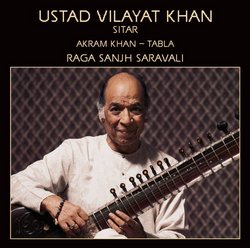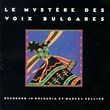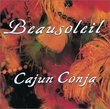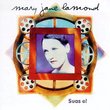| All Artists: Ustad Vilayat Khan;Akram Khan Title: Raga Sanjh Saravali Members Wishing: 0 Total Copies: 0 Label: India Archives Original Release Date: 4/12/2000 Re-Release Date: 4/11/2000 Genres: International Music, Pop Styles: Far East & Asia, Reggae, India & Pakistan, India Number of Discs: 1 SwapaCD Credits: 1 UPC: 731838104027 |
Search - Ustad Vilayat Khan;Akram Khan :: Raga Sanjh Saravali
 | Ustad Vilayat Khan;Akram Khan Raga Sanjh Saravali Genres: International Music, Pop
Ustad Vilayat Khan performs his own creation, delightful and romantic, raga Sanjh Saravali, literally an 'evening melody.' Vilayat Khan presents this in a slow, lyrical development typical of a khayal vocal rendering, and ... more » |
Larger Image |
CD DetailsSynopsis
Product Description Ustad Vilayat Khan performs his own creation, delightful and romantic, raga Sanjh Saravali, literally an 'evening melody.' Vilayat Khan presents this in a slow, lyrical development typical of a khayal vocal rendering, and brings to bear all his creativity and technical prowess to make this performance an enchanting vision of love and beauty. Similarly Requested CDs
|
CD ReviewsSanjh Saravali - Surroundings of the evening Kaushik Roy | Houston, TX United States | 03/06/2001 (3 out of 5 stars) "Sanjh Saravali means 'Surroundings of the Evening', and there is no doubt, Sanjh Saravali portrays a beautiful, romantic evening. Full moon night, smell of Jesmine, nice spring breeze, a touch of sadness, pain of seperation from the beloved ones - all these emotions are very strongly present in this Raga. By nature, Ustad Vilayat Khan is very romantic in nature and his music reflects that very much. But Sanjh Saravali is not one Raga, it is a combination of mulitiple Ragas and the structure is not very well defined. In Hindustani Classical music, every Raga should be well defined, its ascending and descending notes, its prominent phrases, its main note(vadi) and 2nd main note (sam vadi). This is the beauty of Indian classical music. One can improvise, but must stay within the given structure. While improvising, all the main characters of the Raga should be present and that's why such rigorous training is required. Unfortunately, these things are missing from Sanjh Saravli. Sometimes it sounds like Yaman, sometimes it is like Bihag, sometimes it is like Anandi and sometimes, it is like Shuddha Kalyan. All these are prime time evening Ragas and because they are handled by none other that Vilayat Khan, Sanjh Saravali creates an immense impact on the audience. The audience will like the music very much, but for some body who is an orthodox Indian Classical Musician, it will be disappointing." A beautiful "cheez" Houzefa | FRANCE | 04/30/2008 (5 out of 5 stars) "Sanjh Saravali is in fact one of the most beautiful evening melody that Ustad Vilayat Khan has developed; now it is a raga or not? I am not a specialist but I will just quote Khansaheb himself, he said that this composition is a "beautiful cheez" ("cheez" in hindi means litterally "a thing"). It is worth listening and this composition crystalizes all the genius of the one and only Vilayat Khan. A must for all Indian Classical Music lovers !" Ragmala Mark | New York, NY United States | 04/19/2004 (5 out of 5 stars) "I disagree with Kaushik Roy. There are many ragas in North Indian Classical Music which are a mixture of ragas. More importantly, there are many ragas which are quite normally developed during a performance as ragmalas or "a garland of ragas". Sindhu Bhairavi and Misra Pilu are but 2 of the most popular examples. In fact Sindhu Bhairavi is probably the raga played more often than any other to finish a performance. Ustad Vilayat Khan is the master of masters in weaving ragas together in ragmala on sitar, as well as a master in sublimely revealing the elements of hybrid ragas. Thus I highly recommend this recording for anyone interested in expanding their understanding of the music or more simply enjoying the music."
|

 Track Listings (1) - Disc #1
Track Listings (1) - Disc #1








